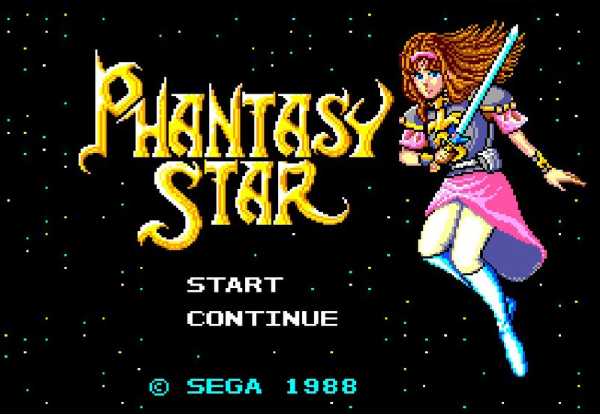
What a difference it makes. The game isn’t that much easier; a wrong turn or an unlucky enemy encounter might still off Alis, our heroine, early in the game. Instead of mollifying the core of its design, M2 just sped it up. Alis goes through everything faster, whether it’s roaming towns or gaining levels, and thus a rigid and sometimes tedious role-playing game becomes compelling in its challenges.
Of course, Phantasy Star is still a relic. The graphics are generally static, the battles follow routine turns, and calling the plot points a storyline is perhaps too charitable. Even with M2’s additions, it might not interest those accustomed to several decades of RPGs with cinematic combat, character customization, actual story arcs, and the ability to decide which enemy you’ll strike.
If you’re willing to envision the game as it was at its late 1987 release, however, Phantasy Star is mind-blowing. Its stage of the Algol star system was a complex fusion of Star Wars and fantasy undertones back when RPGs were still Dungeons & Dragons with perhaps some anime trappings. Its monsters and scenery were all animated and vibrant back when other games stayed stiff and static. It offered an actual, no-kidding Strong Heroine with a name and a solid motivation back when its competitors had generic and uniformly male rosters and anyone who wanted otherwise just had to pretend that the white mage in Final Fantasy was a woman.
And how can you put yourself in a 1987 frame of mind? It involves more than eating a McDLT, listening to Belinda Carlisle’s solo hits, and ignoring the crimes of the Reagan administration. If you follow these five steps early in the game, though, I think you’ll gain the right perspective for Phantasy Star.
STEP 1: DIE REPEATEDLY
Phantasy Star warns you at the start: death is everywhere. The game’s prologue sees Alis’ brother, Nero, die at the hands of the interplanetary despot Lassic. So Alis ventures out of her home city to find a warrior called Odin and liberate the Algol star system. And if you’re not the most cautious player imaginable, Alis will die. She’ll wander north and get mobbed by giant scorpions. She’ll face two Sworm insects in her first battle and narrowly lose to them. She’ll venture too close to the shore and be killed in the first round of combat by a fishman’s spiked tongue.
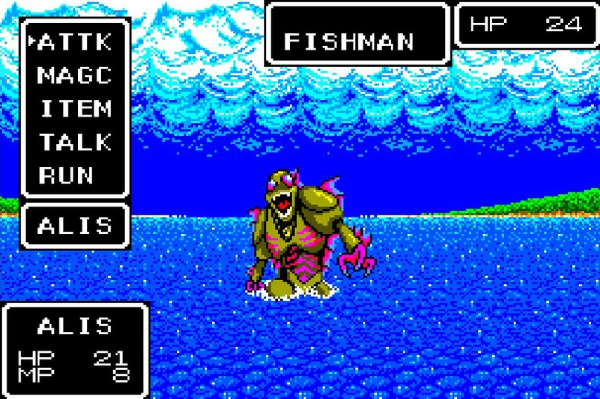
The Sega Ages version dials the difficulty back, but only a little. Alis still faces defeat if she’s overly adventurous or just unlucky, making it easy to imagine yourself as a neophyte RPG player in 1987, fighting and failing until you finally figured out how to use healing items.

This also means that unless you save before these first few battles, a defeat will boot you back to the title screen and make you start fresh, watching Nero die and Alis vow revenge all over again. Perhaps that’s why Phantasy Star has such a brief opening. You’ll see it a lot.
STEP 2: TRY TO FIGHT THE GUARDS
The adventure games of this era reveled in giving players all sorts of lethal options, often inflicting elaborate doom just for opening the wrong door or talking to the wrong secret werewolf. Phantasy Star, for all of its hazards, at least takes it easy on players within civilized space. While in towns and cities, Alis and her companions don’t have to worry about stumbling into certain death. Most of the time.
Even so, audiences of the 1980s might ask why Alis can’t attack the off-brand Stormtroopers in the city. These would be the soldiers of Lassic that keep all the citizens of Algol living in fear. You know, the soldiers who apparently killed Alis’ brother right in front of her.
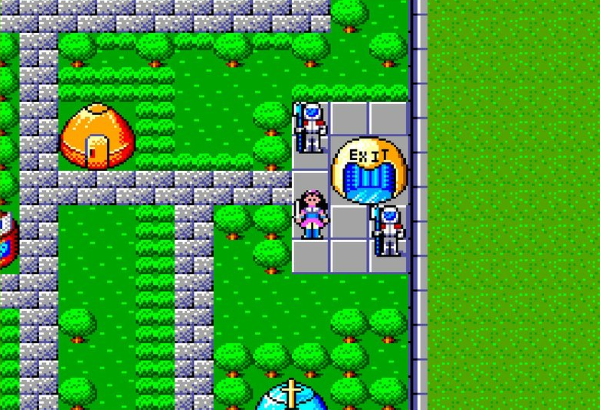
Yet Phantasy Star doesn’t give Alis the option of lashing out at the troopers, not even after she’s gained a few levels and allies. And we’re left to imagine why. Did Lassic himself kill Nero, thus making his minions evil but technically innocent? Does she realize that the tyrant would only send more soldiers, and that she must strike at the source? Or does she simply not know which of them helped murder Nero, since they’re all dressed alike?
STEP 3: CONSIDER THE CHURCH
Most of Phantasy Star’s cities have churches where party members can revive after falling in battle. It’s not useful until Alis adds some comrades, though you might wonder why Alis just didn’t drag Nero to the church and bring him back to life. We must assume that there’s a difference between reversing a public execution and resuscitating someone who just took too many bites from a giant scorpion.
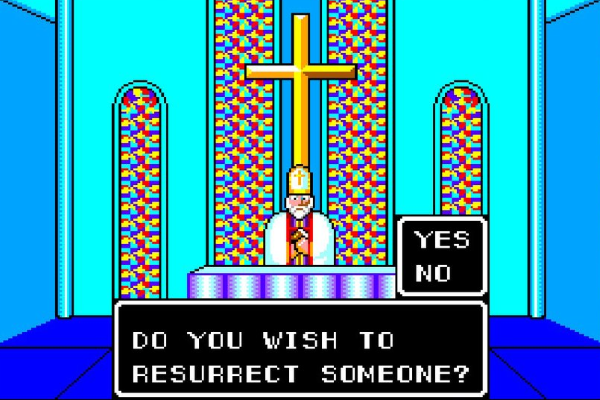
You might also wonder what a church with blatantly Christian trappings is doing on this planet, which presumably lies as long ago and far away as the Star Wars galaxy. Should you presume that, despite no one ever mentioning it, Algol is a lost colony of the Earth? If you do, you’re halfway to ruining the ending of Phantasy Star II for yourself.
Games of the 1980s were good at stoking these crazy speculations. Long dungeon treks and monster hunts were thin on narrative or world-building, so it fell to the players to imagine the workings of Hyrule’s economy or the possible self-awareness of Dr. Wily’s robot minions. So don’t be afraid to overthink Phantasy Star.
STEP 4: EXPLAIN ALIS’ HAIR COLOR
The limitations of Phantasy Star’s era often demolished any attempts at consistent character design. Look at the earliest Metroid, where Samus Aran’s hair is green or blonde or brown or purple depending on which issue of Nintendo Power you read.
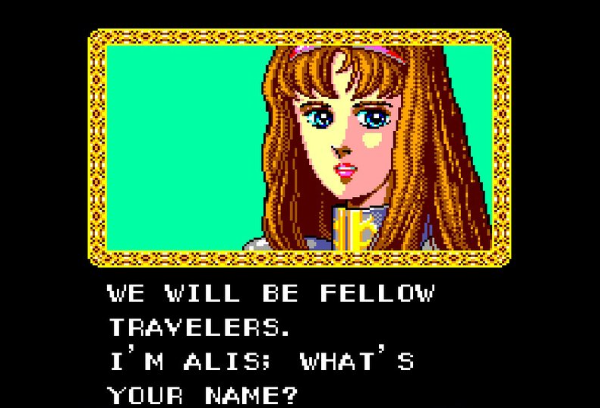
Alis pulls the same trick. Her hair is brown in the game’s opening cutscenes, but she has clearly black tresses two seconds later as she wanders the overworld. The official artwork can’t make up its mind, either. This Sega Ages revamp of Phantasy Star has a credits sequence where the characters march along and admire the game’s illustrations; some depict Alis as brown-haired, others give her black hair.
This is likely due to the palette limitations of the Sega Master System, but we didn’t know that back in 19887. For all we knew, Alis dyed her hair so Lassic’s troops wouldn’t recognize her as the possibly vengeful sister of a slain revolutionary. Maybe her hair changed color with exposure to differen planets’ atmospheres. Anything made sense in a game with a talking psychic cat.
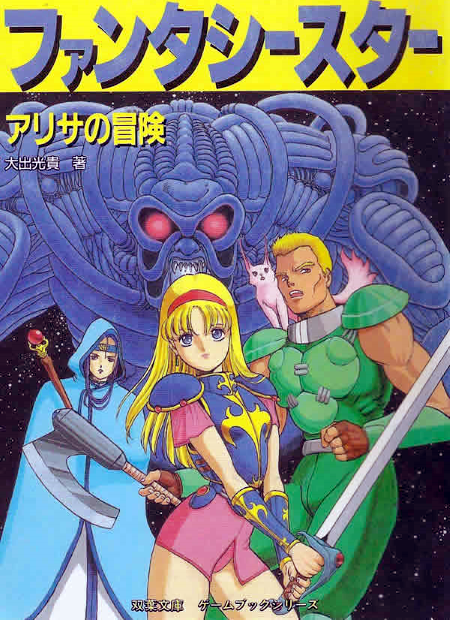
Just to confuse us even more, Sega made Alis bright blonde on the cover of the game’s strategy guide. This held firm years later for her appearance in Segagaga, a wonderful, self-indulgent Dreancast game where players help revive Sega itself. It also has the Battle Mania heroines, so it’s clearly canon.
STEP 5: LAUGH AT THE ITEM NAMES
I sympathize with the people who localized Phantasy Star. Translations were often difficult and crude in this period, and text limitations forced all sorts of abbreviations. You’ll see this early in the game, where instead of buying short swords or titanium swords, Alis can choose from the SHT. SWORD or the TIT. SWORD.
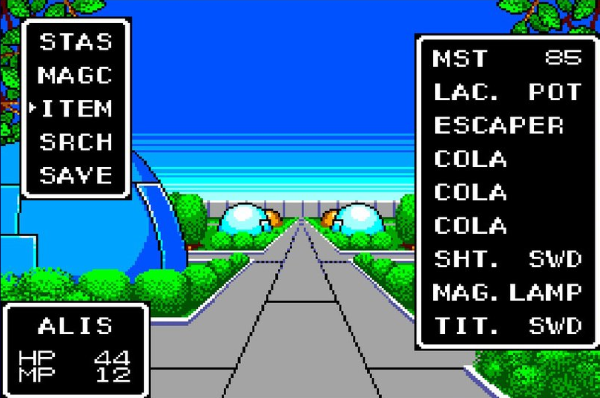
In tribute to those beleaguered editors and programmers of a far more limited era, you should unleash your inner child to mock all of this. Chuckle at the SHT. SWORD. Snicker at the TIT. SWORD. Sputter at the fact that one of Nero’s friends gives Alis an item called LAC. POT. Princess Tomato in the Salad Kingdom avoided this sort of thing by renaming an object from a pot to a vase, but not this game. It wanted POT, and it got POT. And you should appreciate that along with the rest of Phantasy Star.

I bought Phantasy Star shortly after it came out here in ’88. To say it was mind blowing at the time is an understatement. Best graphics of any game at the time. Multiple planets. 3D dungeons. Multiple frames of battle animations. Destructible terrain. These things hadn’t really been done before. It was very easy as an 80’s kid to be sucked into that universe. Having Alis as a heroine was just the icing on the cake. The game was just so different than everything else back then.
ReplyDeleteYou’re right that games of this time were great for having nerd discussions with my friends about the larger game world. The biggest one for us in this game was Noah (Lutz in Japan). The manual for PS refers to Noah as a “he”. But in the game the Governor refers to Noah as “her”. My friends and I had countless debates on whether Noah was male or female. Even looking at the in-game character portrait, it wasn’t obvious to us. We assumed someone messed up the translation somewhere, but which translation was messed up, the manual or the game? In the end we decided that Noah was supposed to be androgynous. In a game of so many firsts, this entirely made sense to our 13 year old minds.
Well, several years ago I found this interview with Reiko Kodama (lead designer) on the making of Phantasy Star. She was asked about Noah (Lutz) and had this to say:
“Since so many people have asked whether Lutz is male or female, let me say a little about that. In the original story drafts of Phantasy Star, Lutz was a hermaphrodite, and as Alisa grew up, Lutz could become male or female. I thought that was interesting so I depicted Lutz that way.”
This literally blew my mind when I read it. I knew all those years something was different about Noah in this game but I just had no way to prove it. Every place I looked online refers to Noah as “he” so for a long time I assumed my childhood curiosity was misguided. But there it was in the interview. My younger self wasn’t so crazy after all.
Yeah, Phantasy Star was way ahead of its time.